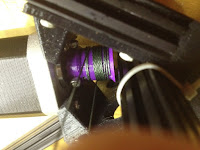Ok, stupid title but sometimes thou gotta let one out.
Anyway, here rev:Alpha of my ShapeOko upgrade on
GitHub.
Overview
 |
| Overview |
In general I think I have met all my design goals. The only compromise was the over all size. At one time I did experiment with what overall size it would take just to load in a 24"x24" panel. The savings did not justify the effort of trimming down the extrusion nor the wood. Leaving the extrusion at 1 meter and foot print 48"x48", the cutting area is about 40"x31".
So size was a compromise but I have room for it and I think this space will be worth it. Unlike other things in my garage this will "pay rent". I may have to do some spring cleaning and "evict" some junk to find this a home.
X-Rail and Gantry Improvements
 |
| X Gantry Box like design |
Because of the noticeable give in my current ShapeOkos gantry I really wanted to solidify the X rail and carriage. I scanned the forums and extracted what I thought was the best ideas for doing so. The upgrade are:
Double X-rails with wlanfox Blocks - It was pretty much a consensus that a Double-X rail would be needed for the meter span. I also thought that the
wlanfox Blocks were an excellent idea and be made of 3/4" plywood. I will use M5 threaded rod and nylock nuts to span the distance of the blocks. I think using nylock nuts all around is a good idea as I have had some nuts loosen and fall off in the middle of a job. Also 4 more V-Wheel Kits are needed.
 |
| Gantry Underside |
Standard Wheel Carriage Plate - Using these instead of the existing motor plate lowers the X-Rail so that the resulting moment arm is reduced. Forces in the Y direction should have less twisting effect on the Gantry and X-Rail assembly. The draw back of this mod is that the Y motors have to be relocated. You can see in the overview picture that they will be mounted on a fabricated item I call the Motor-Buttress assembly (blue). This will require longer timing belts and two additional Smooth Idler Wheel Kits.
 |
| Standard Wheel Carrage Plate |
Part Fabrication
 |
| Idler Butress Assembly |
I will use the ShapeOko to cutout the parts to make the Idler and Motor Buttress Assemblies as well as the wlanfox Blocks. I'm hopeful that I get it right before I tear down the ShapeOko for upgrading. If not then I will have to resort to my skills with hand tools which will be a big time suck and an exercise of patience but we will getr done.















